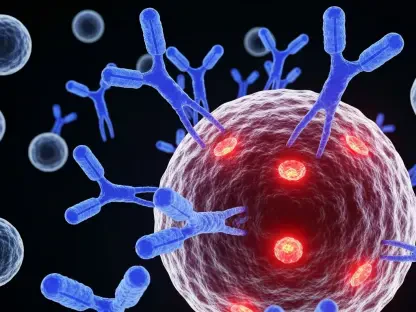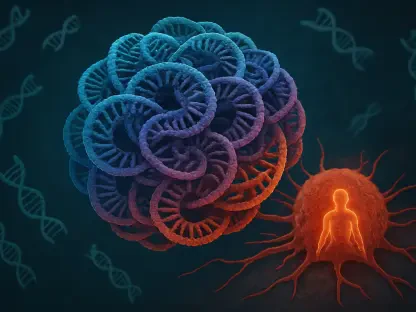The discovery of a critical mechanism involving the protein USP39 has opened new avenues for understanding and potentially treating diseases like retinitis pigmentosa and certain cancers. Researchers have revealed that USP39 plays a crucial role in maintaining the stability of spliceosome subunits within retinal cells, highlighting the protein’s significance in splicing processes necessary for generating protein diversity. Splicing, an essential cellular process that modifies gene transcripts to produce various proteins, can be disrupted by mutations, leading to diseases. By exploring USP39’s involvement, scientists aim to develop targeted therapies that address splicing errors without broadly affecting cellular health.
The Role of Splicing in Protein Diversity
Genes act as blueprints for producing specific proteins, with the human genome containing around 20,000 coding instructions. Despite this relatively small number, the variability and necessary diversity in protein structure and function are achieved through a process called splicing. This process enables cells to generate several hundred thousand different proteins. Splicing occurs in the cell nucleus when a protein is needed. During this process, a cellular editing complex known as the spliceosome modifies the generated transcript by removing specific segments. The segments excised and retained determine the resulting protein structure, thus creating different blueprints for varied proteins. Accurate splicing is crucial for cellular life, as it ensures the correct production of functional proteins essential for cellular operations.
The spliceosome consists of multiple components that ensure the correct production of functional proteins. Disruption in spliceosome functionality often leads to cell death, making spliceosome inhibitors a potential target for anti-cancer treatments. However, complete inhibition affects healthy cells too, leading to significant side effects. Research conducted by an international team led by Goethe University focuses on a part of the spliceosome composed of three subunits: U4, U5, and U6. Mutations in these subunits are associated with the eye disease retinitis pigmentosa, but the exact impact of these mutations had not been fully understood until now.
The Spliceosome and Its Components
Researchers have been investigating the crucial role the spliceosome plays in ensuring protein diversity and cellular function. The spliceosome consists of multiple components that work together to modify gene transcripts during the splicing process, enabling cells to produce a wide variety of proteins essential for various functions. Disruption in the functionality of the spliceosome can lead to severe consequences, including cell death. This makes the spliceosome an attractive target for anti-cancer treatments. However, inhibiting the spliceosome completely can also adversely affect healthy cells, leading to significant side effects.
Recognizing the need for more precise interventions, an international team led by Goethe University has been focusing on a specific part of the spliceosome composed of three subunits: U4, U5, and U6. Mutations in these subunits have been linked to retinitis pigmentosa, a progressive eye disease that can lead to blindness. However, the precise impact of these mutations had remained unclear until recent research shed light on their significance. By delving deeper into the functioning of these subunits, scientists aim to uncover targeted treatment methods that can mitigate the negative effects without harming healthy cells.
USP39 and Its Role in Spliceosome Stability
Through a combination of experiments on zebrafish and mathematical calculations, a recent study delved into the role of USP39 in stabilizing the spliceosome subunits U4, U5, and U6. The findings reveal that USP39 is crucial for maintaining the stability of this tripartite spliceosome complex, ensuring that splicing occurs with precision. When subunits are mutated, or USP39 is absent, the stability of the spliceosome is compromised, leading to errors in the splicing process. This inaccuracy can produce faulty transcripts, resulting in dysfunctional proteins that can accumulate and form aggregates within the cells.
The absence of USP39 or the presence of mutated subunits leads to delayed re-joining of transcript ends during splicing, increasing the likelihood of incorrect connections. These inaccuracies produce faulty transcripts which result in dysfunctional proteins. These defective proteins can overwhelm the cell’s waste disposal system, leading to cellular dysfunction and ultimately cell death. In retinal cells of zebrafish, this process has been observed to cause significant damage, mirroring the effects seen in human diseases such as retinitis pigmentosa. The study underscores the importance of USP39 in safeguarding the precision of splicing processes, highlighting its potential as a therapeutic target.
Implications for Retinitis Pigmentosa
The discovery of USP39’s role in spliceosome stability extends beyond just understanding the molecular mechanisms of splicing. It has significant implications for retinitis pigmentosa, a genetic disorder that leads to the degeneration of retinal cells and eventual vision loss. The defective splicing mechanism, which leads to the accumulation of dysfunctional proteins, may provide an explanation for why retinal cells die in patients with this disease. Understanding this process opens the door to developing targeted therapies aimed at correcting splicing errors at the molecular level, potentially offering new hope for patients suffering from this debilitating condition.
The insights gained from this research emphasize the critical role of USP39 in maintaining spliceosome stability and precision. By focusing on USP39, researchers can aim to develop therapies that correct splicing errors without broadly compromising cellular health. This approach could mark a significant advancement in the treatment of retinitis pigmentosa, paving the way for interventions that specifically address the root causes of the disease. The therapeutic potential of targeting USP39 could help prevent retinal cell death and slow the progression of vision loss, significantly impacting patients’ quality of life.
Potential for Cancer Treatment
Cancers that are highly aggressive tend to produce large amounts of USP39 and related splicing factors, as these tumors have a high division rate and require precise splicing for constant protein production. Targeting USP39 could offer a novel approach to cancer treatment by selectively killing cancer cells while sparing healthy ones. This selective targeting approach aims to exploit the high dependency of aggressive tumors on accurate spliceosome function, providing a focused means of attacking the cancer cells. The research team investigating USP39’s role in splicing stability is exploring this selective targeting method to develop potential cancer therapies.
Blocking USP39 in cancer cells could reduce their splicing precision, leading to the production of faulty proteins that hinder their rapid division. This targeted strategy could minimize the side effects commonly associated with traditional cancer treatments that affect both healthy and cancerous cells. By honing in on USP39, researchers hope to create therapies that better discriminate between normal cells and those that are cancerous, ultimately improving patient outcomes. This innovative approach underscores the potential of USP39 as a pivotal player in the development of new cancer treatments, making it a promising target for future research and therapeutic interventions.
Broader Implications for Neurodegenerative Diseases
The defective splicing mechanism identified in this study may not be limited to retinitis pigmentosa but could also play a crucial role in the development of neurodegenerative diseases such as Alzheimer’s and Parkinson’s. Similar to the process observed in retinal cells, the accumulation of defective proteins due to splicing errors could lead to cell death in brain cells, contributing to the progression of these neurodegenerative conditions. Understanding the role of USP39 in stabilizing spliceosome components may provide insights into the pathology of these diseases and open new therapeutic avenues for their treatment.
Targeted manipulation of the splicing mechanism could potentially prevent the accumulation of defective proteins in brain cells, slowing the progression of neurodegenerative diseases. By correcting splicing errors at the molecular level, it may be possible to maintain the health of nerve cells and prevent the onset of debilitating conditions such as Alzheimer’s and Parkinson’s. This approach underscores the broad implications of research into USP39 and spliceosome stability, highlighting its potential impact on a wide range of diseases beyond just retinitis pigmentosa and cancer.
Future Directions in Splicing Research
The discovery of a vital mechanism involving the protein USP39 has opened new pathways for understanding and potentially treating conditions such as retinitis pigmentosa and certain cancers. Researchers have found that USP39 is essential in maintaining the stability of spliceosome subunits within retinal cells, underscoring the protein’s importance in the splicing processes crucial for generating protein diversity. Splicing is a key cellular process that modifies gene transcripts to produce a variety of proteins. When mutations disrupt this process, it can lead to various diseases. Scientists are now delving into how USP39 functions in this context. Their goal is to develop targeted therapies that correct splicing errors while minimizing impacts on overall cellular health. This focused approach could provide precise treatments for splicing-related conditions without the broad side effects often seen with other therapies. Therefore, the role of USP39 in maintaining proper cellular function and health could be groundbreaking for future medical advancements.









